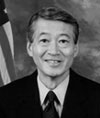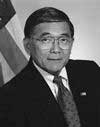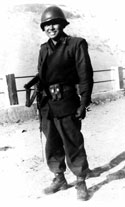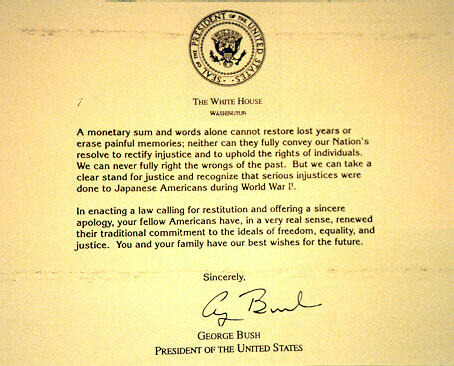|

Image information: Manzanar street scene, clouds, Manzanar Relocation Center, California, photograph by Ansel Adams, digital file from original print http://hdl.loc.gov/loc.pnp/ppprs.00284
Japanese-American
Internment
During
World War II, the federal government ordered 120,000 Japanese-Americans
who lived on the West coast to leave their homes and live in 10
large relocation camps (see Internment
Map) in remote, desolate areas, surrounded by barbed wire
and armed guards. Two-thirds were native-born American citizens.
|
Evacuation
sale during Japanese Relocation. FDR Library. |
Japanese-Americans
were interned as a result of an executive order (see Executive
Order No. 9066) by President Roosevelt in 1942. About 77,000
American citizens and 43,000 legal and illegal resident aliens
were affected by the order. The last camp was closed in January
1946, five months after World War II ended.
It
would not be until 1988 that the U.S. government formally apologized,
provided compensation to those who were interned, and created
an education fund to preserve the history and to teach the lessons
of this shameful episode. (see Redress
for Japanese Internees)
 |
Two
of the chief backers of a national apology had themselves
been interned. Representative Robert Matsui of California
was 6 months old when his family was interned.
His
family had just 48 hours to relocate. His father was forced
to sell their house in Sacramento for $50 and simply abandon
his small produce business. |
 Learn
more about Robert Matsui and the internment of his family
at Tule Lake Camp. (see Recalling the
U.S. Internment of the Japanese With Congressman Robert
Matsui, John F. Kennedy Library and Foundation Responding
To Terrorism Series, November 4, 2001) Learn
more about Robert Matsui and the internment of his family
at Tule Lake Camp. (see Recalling the
U.S. Internment of the Japanese With Congressman Robert
Matsui, John F. Kennedy Library and Foundation Responding
To Terrorism Series, November 4, 2001) |
U.S.
Secretary of Transportation Norman Mineta of California
was ten years old; he and his family were forced to live,
at first, in a converted stables at a racetrack; later,
they spent a year in an internment camp in a forbidding
part of Wyoming.
Mineta
recalled being given the priviledge of signing the House
bill, HR 442, after it had passed. |
 |
"There
has never been a moment when I loved this country more,"
he said. Redress was "the best expression of what
this nation can be and the power of government to heal
and make right what was wrong."
 Learn
more: Japanese
American National Museum Learn
more: Japanese
American National Museum
|
| 
|
Another
sponsor, Democrat Senator Daniel K. Inouye of Hawaii,
who served in the 442nd regiment combat team, made up
entirely of Japanese Americans. He lost his right arm
fighting in Italy and was awarded a Bronze Star and two
Purple Hearts.
Learn
more about the 442d combat team in "21
Asian American World War II Vets to Get Medal of Honor"
He
was first Congressman from Hawaii and the first American
of Japanese descent to serve in either House of Congress. |
 Learn
more about Senator Inouye's combat experience during World
War II from his website, Go
For Broke, a condensation of his book, Journey
to Washington. Learn
more about Senator Inouye's combat experience during World
War II from his website, Go
For Broke, a condensation of his book, Journey
to Washington.
|
The
warning radio suddenly emitted a frenzied cry: "This
is no test! Pearl Harbor is being bombed by the Japanese!
I repeat: This is not a test!"
"Papa,"
I cried, and then froze into stunned immobility. Almost
at once my father was in the doorway with agony showing
on his face, listening, caught by that special horror
instantly sensed by all Americans of Japanese descent.
".
. . not a test. We can see the Japanese planes . . ."
|
''Yes,
the nation was then at war, struggling for its survival,'' said
President Ronald Reagan at the White House. ''And it's not for
us today to pass judgment upon those who may have made mistakes
while engaged in that great struggle. Yet we must recognize
that the internment of Japanese-Americans was just that, a mistake.''
More than a mistake, it was a grave violation of civil liberties
and a blot on America’s commitment to constitutional rights.
 |
The
Civil Rights Act of 1988 (HR442) awarded redress
to all surviving internees or their relatives.
President George Bush sent this formal apology letter
along with a $20,000 check. |
Exploration
Questions
- Why
were Japanese Americans expelled from their homes and incarcerated
in internment camps - even though not one Japanese American
was charged with espionage or sabotage during the war - and
why did internment last, on average, for nearly three years?
- Why
were west coast Japanese American citizens relocated - while
Japanese Americans in Hawaii and German-Americans and Italian-Americans
were not?
- Why
were all west coast Japanese Americans interned, citizens
and aliens, children and adults, and why was this policy upheld
by the federal courts?
- What
was the impact of this experience upon the lives of Japanese
Americans?
|
